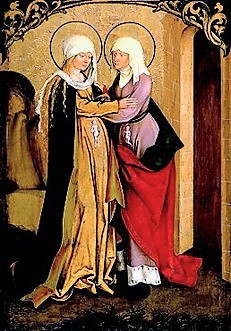 |
| The Visitation and the Naming of John the Baptist from an Evangeliary German (Hildesheim), c.1015 Hildesheim, Dom-Museum |
“And Mary said:
"My soul proclaims the greatness of the
Lord;
my spirit rejoices in God my Savior,
for he has looked with favor on his lowly
servant.
From this day all generations will call me
blessed:
the Almighty has done great things for me,
and holy is his Name.
He has mercy on those who fear him
in every generation.
He has shown the strength of his arm,
he has scattered the proud in their conceit.
He has cast down the mighty from their
thrones,
and has lifted up the lowly.
He has filled the hungry with good things,
and the rich he has sent away empty.
He has come to the help of his servant
Israel
for he has remembered his promise of mercy,
the promise he made to our fathers,
to Abraham and his children forever."
Luke
1:46-55, Excerpt from the Gospel for the Feast of the Visitation of the Blessed
Virgin Mary, May 31st
We have just
looked at a series of iconographical motifs associated with the Visitation, the
meeting between the newly pregnant Virgin Mary and her older, previously barren
but now near-term, relative Elizabeth.
We have seen that artists have presented motifs from simple greeting, to
the kneeling Elizabeth acknowledging the Presence of the Savior within her
cousin, to gestures of blessing and finally to showing us the two unborn babies
interacting. These are the primary ways
in which artists have portrayed the event.
Much less frequent has been their presentation of the response to the
events of the Visitation on the part of Mary, expressed in the great hymn of
the Magnificat.
For these
purposes I will not get into a discussion of the origins of the Magnificat. For our purposes it is immaterial whether
they are the actual words of Mary, expressed to the Evangelist Luke, or whether
they are an early Marian hymn inserted into the Gospel account. For the artist it really doesn’t matter. It is the words and their association with
Mary at the moment of the Visitation that matter.
 |
| The Annunciation and The Visitation from a Psalter English (London), First Quarter of the 13th Century London, British Library MS Landsdowne 420, fol. 7 |
I have found
only a handful of images that specifically indicate the Magnificat. Two come from
the Middle Ages, one from the eighteenth century and one from the nineteenth
century. There are, no doubt, more but I
have not yet uncovered them. This seems
odd in view of the fact that the Magnificat
is one of the best known prayers of the church, recited every evening at
Vespers/Evening Prayer/Evensong and both recited or sung at other times as well
and set by significant composers from the middle ages through Arvo Pärt.
In the two medieval examples, the moment is made clear through the addition of banderols held by Mary or by Mary and Elizabeth, on which texts are written. Those held by Mary in both examples contain the opening word or words of the prayer “Magnificat anima mea Dominum et exultavit spiritus meus in Deo salutari meo.” (My soul magnifies the Lord and my spirit rejoices in God my Savior.”) The banderol held by Elizabeth in the later image contains the words of her greeting “Benedicta tu inter mulieres et benedictus fructus ventris tui et unde hoc mihi ut veniat mater Domini mei ad me” (“Blessed are you among women and blessed is the fruit of your womb and how is it that the Mother of my Lord should come to me?”).
In the two paintings from the later time periods things are not quite as clear cut. We need to know a bit about the story to understand what is happening. In the Maulbertsch picture Mary has climbed the stairs to the home of Elizabeth and Zechariah, who are seen receiving her. Spectators and servants look on and angels wheel about overhead. Bathed in a celestial glow, Mary lifts her hands ecstatically and we can almost here her proclamation “Magnificat anima mea Dominum!”
In the
nineteenth-century image by James Tissot things are much quieter. Tissot had painted a straightforward picture of the Visitation, in the simple greeting form (here). In this picture, however, we see no heavenly host or crowd of
spectators, just a young woman standing with eyes closed and hands uplifted in
prayer being watched by an old woman and old man.
The expression of astonishment on the face of
the old woman suggests that something unusual has happened. Reading between the lines, as it were, we can
conclude that this is an image of the moment during the Visitation when Mary
responds. But we are the ones who have
to draw the conclusion. Tissot does not
help us with supernatural fireworks. Such
is the difference between the modern period and what has gone before.
©
M. Duffy, 2017
Excerpts from the
Lectionary for Mass for Use in the Dioceses of the United States of America,
second typical edition © 2001, 1998, 1997, 1986, 1970 Confraternity of
Christian Doctrine, Inc., Washington, DC. Used with permission. All rights
reserved. No portion of this text may be reproduced by any means without
permission in writing from the copyright owner.


















































